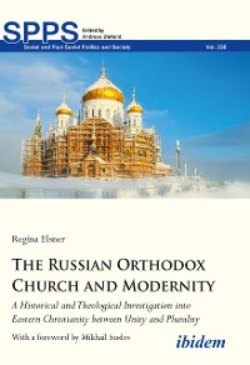Читать книгу The Russian Orthodox Church and Modernity - Regina Elsner - Страница 7
На сайте Литреса книга снята с продажи.
Modernity
ОглавлениеA central reference point of this work is modernity. As the term ‘modernity’ is one of the most dazzling terms in humanities and social sciences research, it represents a challenge for any work that bears this term in its title. It is not possible at this point to provide a detailed account of the various definitions and accentuations of modernity or post- or late modernity in general and their relationship to religion in particular. One can refer to the recent work of Boris Krause: “Religion und die Vielfalt der Moderne” (Krause 2012) and the anthology “Moderne und Religion. Kontroversen um Modernität und Säkularisierung” (Willems et al. 2013) for a comprehensive insight into the ongoing debates. However, it does not seem useful to approach the ROC with the categories of primarily Western concepts of modernity and modernization, since this would imply a fundamental contradiction, which would still have to be proven, and would furthermore perpetuate the claim to superiority of many theories of modernity (Eisenstadt 2003). Accordingly, this study focuses on the concepts of modernity, which occur within the Russian Orthodox argumentation and polemics and thus most accurately describe the understanding of modernity on which the Church is currently working.
The starting point of this work is the observation of an ongoing conflict of the Russian Orthodox Church with certain societal phenomena classically associated with modernity: Individualization, rationalization, secularisation. These terms refer primarily to the normative project of modernity as described above all by Habermas (Habermas 1987; Bonacker 2001). In these phenomena, the ROC criticizes certain value concepts, which it characterizes as culturally alien and thus also suggests that this modernity can be circumvented.
At the same time, the Orthodox polemics against these phenomena also show a conflict with the sociological-structural concept of modernity, i.e. a growing differentiation of society. The paradox that the ROC benefits from the structures and mechanisms of modern society and at the same time criticizes them is, among other things, one of the initial questions of the present study.
If one looks for a common denominator in the variety of definitions of "modernity", it is probably the demarcation from something old, pre-modern or traditional, as well as the orientation towards the future. As Boris Krause describes, in this sense discontinuity becomes a central common feature of all variations of modernity. Closely connected with this is the concept of modernization, that is, of transition—as a break or as a fluid renewal—from something previous to something current (Krause 2012, 33). The ROC's almost existential search for continuity in its own or in Russian history illustrates the fundamental conflict with this aspect of modernity.
These three aspects of the definition of the modern—the normative claim, the structural differentiation with the end of the meta-narrative and the experience of discontinuity—guides the following investigation. Thus, this work is not ostensibly oriented to already existing comprehensive theories of modernization or modernity, even if these three leitmotifs do have correspondences in such theories. However, an attempt is made to keep the area of tension open between these theories and the ideas of modernity formulated by the ROC. This approach is intended to account for the fact that a mere juxtaposition of modernity, however defined, on the one hand, and the ROC on the other, would automatically imply an opposition. Even if many statements by the ROC suggest that one could escape what they perceived as Western modernity, it can be assumed that the ROC itself lives under the conditions of a modern society and has found a specific way of dealing with it. As Julia Lis notes for the Orthodox churches in the Balkans, the ROC, too, "does not simply face unchanged a modernization process to which it must relate, but is itself also interwoven in it, helping to shape it, but also changing in it and through it." (Lis 2019, 310) It is the task of this work to examine this process and the ROC’s formative and changing position in its own theological categories.
